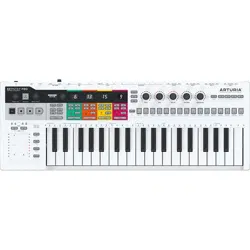Loading ...
Loading ...
Loading ...

In Drum mode, switching between Mono and Poly has a different effect. In Poly mode, each
of the 24 drum tracks can have a different length. In Mono mode, they share the same
length. Please refer to Chapter 5 [p.92] for details.
Arp (Arpeggio) Pattern
To activate this Shift function, hold down the 'Shift' button and press the appropriate key (F,
F#, G, G#, A, Bb or B in the lower octave).
The KeyStep Pro can transform any chord you are holding down on the keyboard into
an arpeggio. It can arpeggiate your chord in seven ways: up, down, exclusive pendulum,
inclusive pendulum, random, in the order you played them or polyphonically.
There's a lot to be learned about this function, so we have devoted a
whole section
[p.63] to the wondrous secrets of arpeggiation and specifically to the KeyStep Pro's unique
arpeggiation features.
Arp Octave
To activate this Shift function, hold down the 'Shift' button and press the appropriate key (C,
C#, D, D# or E in the middle octave).
By default, the arpeggiator will play the notes you are holding down and stay within the
limits of one octave. The Arp Octave -1, 0, +1, +2 and +3 buttons will extend the notes beyond
that range. If you change the octave range, the arpeggiator will also play notes in the
octaves above and below the chord you are playing. Press 'Shift' + an Arp Octave key to
change the range.
Time Division
To activate this Shift function, hold down the 'Shift' button and press the appropriate key (F,
F#, G, G# or A in the middle octave).
Time Division can be applied to both the arpeggiators and the sequencers. Much of the fun
of arpeggios is that they can run at various speeds. If you mix them with sequences and
change speed, it will have a great overall effect. The KeyStep Pro features three arpeggiators
that can run simultaneously and at different speeds!
By default, an arpeggiator will run in 1/16th straight-note speed, but there are four straight-
note speeds to choose from: 1/4, 1/8, 1/16 and 1/32. Each of these speeds can also run in
triplet mode, so alltogether there are eight speed options. You can have one arpeggiator
running in 1/16th straight-note speed and another in 1/8th triplets speed. There are lots of
creative options to explore here!
The sequencers (including the drum sequencer) can also run at these different speeds. You
could, for example, run copies of the same pattern in different tracks at different speeds.
There's unlimited potential for discoveries here.
Each pattern can have its own time division, which is stored with the pattern. This allows
you to create chains of the same pattern in different time divisions.
52 Arturia - User Manual Keystep Pro - KeyStep Pro Overview
Loading ...
Loading ...
Loading ...
